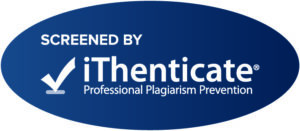In my last blog I discussed the need for referencing in articles submitted to the journal. One of the reasons for referencing that I mentioned was that it gives credibility to your work. The process of reviewing also lends credibility because, by the time a paper is published, it has been through a rigorous screening (review) process. The method of reviewing papers is one of the reasons that it can take quite some time before a paper is finally published.
Over the next few blogs, I will explain the review process of the IAFOR Journal of Education and also outline what is included in the review form. This should be of assistance for those of you submitting papers and also for anyone who hopes to become a reviewer. This week concentrates on the start of the process. A flowchart of the full review process can be found at https://iafor.org/journal/iafor-journal-of-education/publication-process-flowchart/.
Pay attention to what you are agreeing to when you submit!
Before the system allows you to submit your paper there are several things that you agree to. The first page of the portal outlines what plagiarism is and you have to click on a button stating that you have read the page and believe that you have not plagiarised. Please read the page carefully as it outlines what constitutes plagiarism.
After moving to the next page, there is again a list of reminders before you start filling in the submission form. As with the reminders about plagiarism on the page prior, these reminders are there for you to check that you have done everything you can to improve your chances of moving through the review process: met scope, followed author guidelines, and so on.
Once you have filled in all the necessary details it is important that you carefully read the things that you are agreeing to if you continue with submission. This agreement is made between you and IAFOR that everything has been carried out properly. Importantly, you declare a very major ethical consideration:
- I/We confirm that this manuscript is not under consideration, accepted for publication or published elsewhere.
You should also check the other statements as they refer to copyright.
From submission to Editor-in-Chief
Once you submit your paper through the submission portal an automatic email is generated alerting me, as Editor-in-Chief, that there has been a new submission. There will also be an automatic email sent to you confirming that the submission has gone through.

When a report is produced, it highlights areas that are the same as other publications. I turn the filter off for the quotes and bibliography (meaning they are not included) before checking the report. Common words and phrases are discounted as these are used frequently by many authors. I then more carefully examine blocks of highlighted words. I can also check through the system where these blocks have previously been used. It is this check that determines whether a paper is rejected for plagiarism. If this occurs, I also send the report with the email so that you can learn from any errors you have made.
The other major checks that I make are whether the paper is in scope and general word length. As we have several issues a year on different themes, it is important that you submit to the correct issue. We also have a word count guideline of 4,000 to 7,000 words (including the reference list). Papers that are not in scope or are well above or below the word count are rejected.
Initial notification
You will be notified of what is happening with your paper within a week (unless there are circumstances which preclude me from accessing the internet). These checks are very quick as iThenticate does not take very long to produce a report and it is clear whether a paper is in scope within minutes. The email from me will either tell you that your paper is being sent on to the issue editor or that it has been rejected. If it goes to the editor, an even more stringent review begins. More on this next time!
Please remember to read the initial submission portal information and we look forward to your papers,
Yvonne
Dr Yvonne Masters
Editor-in-Chief
IAFOR Journal of Education
Read other posts on the review process –

